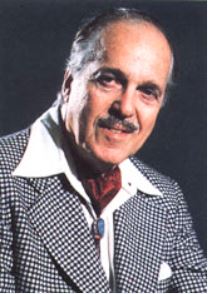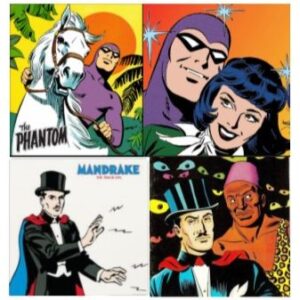Overview
Lee Falk, born Leon Harrison Gross in 1911, wasn’t just a comic book creator; he was a weaver of legends, a sculptor of superhero archetypes. His name is forever intertwined with two iconic figures that have captivated audiences for generations: The Phantom and Mandrake the Magician.
In 1934, Falk’s imagination conjured Mandrake, a debonair magician and master escape artist who used his talents to fight crime and injustice. This suave sleuth, often accompanied by his faithful companion Lothar, paved the way for the superhero genre that later became dominant in the comics world.
Two years later, Falk gave birth to his magnum opus: the Phantom. This masked vigilante, sworn to defend his tiny jungle nation for generations, became a global phenomenon. The Phantom’s unwavering commitment to justice, symbolized by his skull ring and unwavering resolve, resonated with readers across cultures and continents.
Lee Falk’s genius wasn’t limited to creating iconic heroes. He crafted rich worlds, populated with vibrant characters, thrilling adventures, and timeless themes. His narratives explored the depths of human nature, tackling corruption, greed and the struggle for good against evil. Falk’s legacy is a testament to the power of imagination. He gifted us heroes who transcended the pages of comic books, becoming symbols of hope and justice that continue to inspire and entertain readers of all ages.
Field(s) of contribution: Comics creator, writer, cartoonist
Years when active: 1934-1999
Wiki site: Visit
SunilsLists link: Visit
Notable characters or comic series
The Phantom, plus many supporting characters including Diana Palmer, Hero, Devil, Guran, Jungle Patrol, Rex King.
Mandrake the Magician, plus many supporting characters including Lothar, Narda, Hojo, Theron. and Mandrake’s half-sister Lenore.
Unlike the Phantom, Mandrake has a set of many recurring enemies such as his evil twin brother Derek, the Cobra, the Clay Camel, Aleena the Enchantress and the powerful crime organization known simply as “8”.
Frequent collaborators
Lee Falk personally scripted both the Phantom and Mandrake newspaper strips for over six decades, starting from the creation of the two characters in the mid-1930s until his death in 1999. Thus, he really did not have any major collaborators in writing the comics for either character. In regard to drawing the Phantom and Mandrake stories, Falk partnered with relatively few artists during his lifetime, as each artist each had a very long tenure.
For his Mandrake stories, Falk started with Phil Davis, who drew Mandrake for 30 years until his death in 1964. The art was then taken over by Fred Fredericks, who outlasted Falk and even took over the scripting after Falk’s death in 1999.
For the Phantom stories, the early stories were drawn by Ray Moore, who started as an assistant to artist Phil Davis on Falk’s Mandrake stories. In 1949, Moore was succeeded by Wilson McCoy, who drew the strip until his death in 1961. The artwork was then taken over by Sy Barry, who became the definitive Phantom artist and whose portrayal of the Phantom is the most recognizable and set the standard for all the others who followed.
It is truly remarkable that during the 60+ years that Falk created his Phantom and Mandrake stories, he worked with only two Mandrake artists (Davis and Fredericks) and only three Phantom artists (Moore, McCoy and Barry).
Did you know?
Mandrake the Magician, created in 1934, is widely regarded by comics historians as the first ever comics super-hero, i.e., a character who has special powers or skills beyond those of normal humans. Thus, Lee Falk was the pioneering genius who launched the super-hero genre which has so widely permeated popular culture since the late 1930s. However, he did not stop with Mandrake but went a step beyond by creating the Phantom.
The Phantom was the first fictional hero to wear the skintight costume which has became a hallmark of comic-book super-heroes. He was the also first shown in a mask with no visible pupils. The latter has become a standard for nearly all masked super-heroes who followed, most notably Batman.
Because the names of many of Falk’s characters and places could have been perceived to be offensive to Indians, they were changed in the Indian comics (mainly Indrajal). So, “Singh” became “Singa” and “Bengali” became “Denkali”. (Incidentally, the latter is also known by other names Bengalla and Bangalla.)
Lee Falk was so dedicated to his comic strips that even on his death bed, he took off his oxygen mask and dictated his last Phantom stories to his wife Elizabeth during her visits to see him at the hospital!
Additional Information
The Phantom and Mandrake are among the most iconic and widely recognizable super-heroes across the world. Some regions where the Phantom is hugely popular are India, Australia and the Scandinavian countries.
In Scandinavia, there is a Phantom comic magazine called Fantomen that has been continuously in publication since 1950! The success of the comic led the publishers to create new stories exclusively for Fantomen starting in 1963. These comics were produced by “Team Fantomen”, which is the collective term for the artists and writers, responsible for the Scandinavian stories about the Phantom.
There is even a Phantom fan club in Sweden called Fantomen Klubben (which translates to ‘Phantom Club’) which was established in 1950, in Sweden by Semic Press (the publishers of Fantomen at the time). This club is considered to be the first Phantom fan club to be formed in the world and is still running today.
There are dedicated websites with a wealth of information on each of Falk’s iconic characters: PhantomWiki and MandrakeWiki.


